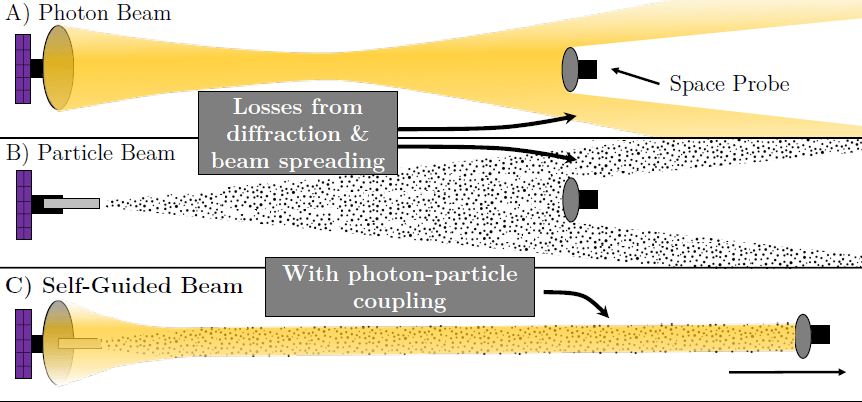Getting to Proxima Centauri b will take a lot of new technologies, but there are increasingly exciting reasons to do so. Both public and private efforts have started seriously looking at ways to make it happen, but so far, there has been one significant roadblock to the journey - propulsion. To solve that problem, Christopher Limbach, now a professor at the University of Michigan, received a grant from NASA's Institute for Advanced Concepts (NIAC) to work on a novel type of beamed propulsion that utilizes both a particle beam and a laser to overcome that technology's biggest weakness.
Let's first look at why conventional propulsion systems wouldn't work to get a craft to Proxima b. Conventional rockets are out of the question, as their fuel is too heavy and burns up too quickly to get a probe anywhere near the speed it would need to reach Proxima b. Conventional solar sails also fail because once they are far enough away from the Sun, only a minimum push is applied to them.
Other non-conventional solutions could work, such as nuclear propulsion or ion drives. However, they fall victim to the tyranny of the rocket equation - since they have to carry their fuel, they have to carry more mass to go faster, thereby eliminating much of that benefit.
Fraser explains Breakthrough Starshot, a mission that could potentially utilize the PROCSIMA system.That leaves beamed propulsion—essentially creating a giant beam in space that continues to push on a spacecraft with a collector on it, which can continue to push the entirety of the time the spacecraft is on its way to its destination. Typically, there are two types of beams used in these systems—particle beams and light beams. However, each has a weakness—diffraction.
Both light and particle beams tend to spread out over long distances, making them much less effective at focusing on a single small object that might be light years away. Even lasers, if allowed to point far away, eventually scatter into unusable light. However, there is a way around this.
Recently, optics research has developed a way of combining particle and laser beams that all but eliminates diffraction and beam spreading when both are used simultaneously. This would allow a beamed propulsion system to continue concentrating its beam on exactly the right place without slowly losing its pushing force as the probe gets further away. Dr. Limbach used this underlying technology to develop what he calls PROCSIMA, a novel propulsion method that used a coherent combined particle and laser beamed propulsion system.
Calculations by Dr. Limbach and his collaborator, Dr. Ken Hara, now a professor at Stanford, show that making a coherent beam that can effectively last to Proxima b while only diffracting out to about 10m is possible, at least in theory. According to their calculations, a 5g probe like the one that the Breakthrough Initiatives project is working on could be pushed up to 10% of the speed of light, allowing it to reach Proxima b in 43 years.
Alternatively, they also calculated that a much larger probe of around 1kg could reach the system in around 57 years. That would allow for a much more exciting payload, even if the probe would zoom through the Proxima Centauri system at a significant fraction of the speed of light.
There is still some work to be done, including developing things like cold atom particle sources and improving the functionality of the beam systems. However, so far, the project hasn't been supported by another NIAC grant, though Dr. Limbach's lab at UM continues to work on similar ideas, such as a nanoNewton propulsion system. Development continues on a star shot method to eventually get a probe to another star, and it seems like, for better or worse, beamed propulsion is the way we will get there.
Learn More:
Limbach & Hara - PROCSIMA: Diffractionless Beamed Propulsion for Breakthrough Interstellar Missions
UT - Starshot … Not? Get a Reality Check on the Search for Alien Civilizations
UT - Photonic Crystals Could Be Exactly What Breakthrough Starshot is Looking For
UT - Tiny Swarming Spacecraft Could Establish Communications with Proxima Centauri
Lead Image:
Artist's depiction of the PROCSIMA propulsion system concept.
Credit - Christopher Limbach
 Universe Today
Universe Today

